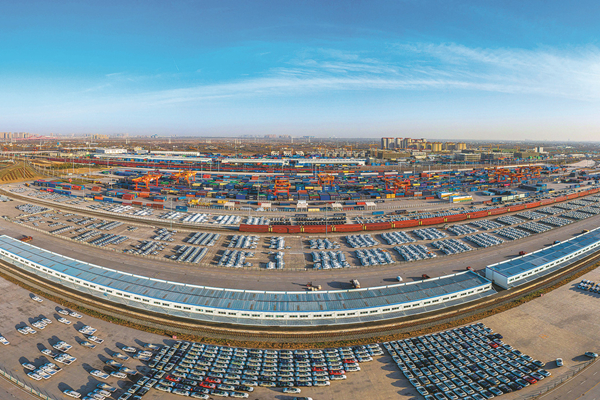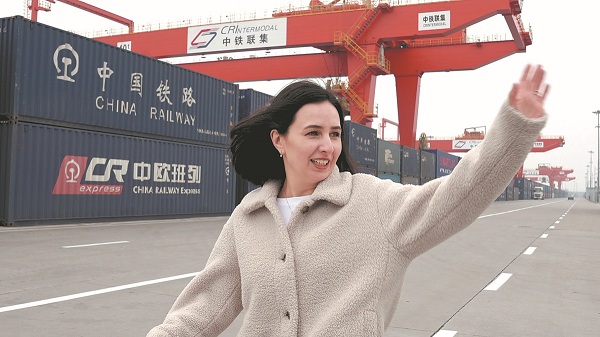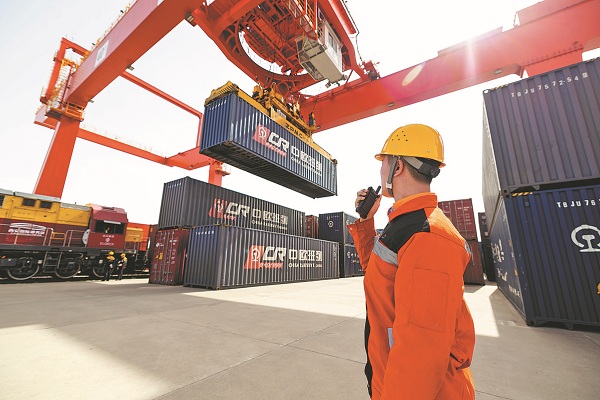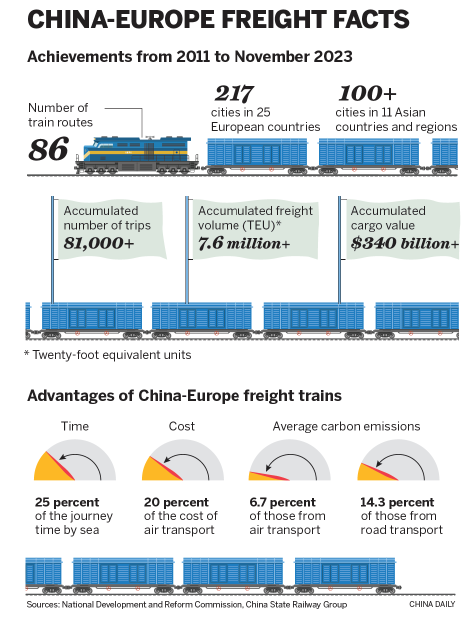
- Home
- Media Center
-
Events
- Wuzhen Summit
- Regional Forums
- Practice Cases of Jointly Building a Community with a Shared Future in Cyberspace
- World Internet Conference Awards for Pioneering Science and Technology
- The Light of Internet Expo
- Straight to Wuzhen Competition
- Global Youth Leadership Program
- WIC Distinguished Contribution Award
- Membership
- Research & Cooperation
- Digital Academy
-
Reports
- Collection of cases on Jointly Building a Community with a Shared Future in Cyberspace
- Collection of Shortlisted Achievements of World Internet Conference Awards for Pioneering Science and Technology
- Reports on Artificial Intelligence
- Reports on Cross—Border E—Commerce
- Reports on Data
- Outcomes of Think Tank Cooperation Program
- Series on Sovereignty in Cyberspace Theory and Practice
- Other Achievements
- About WIC
- 中文 | EN

Spirit of the Silk Road lives on in Xi'an

A panorama of the Xi'an Guojigang Railway Station in Xi'an, Shaanxi province, on Nov 28. YUAN JINGZHI/FOR CHINA DAILY
A decade of success reflects the city's renaissance as countries and cultures are linked through efficiency and cooperation. China Daily reports.
In 2006, when Anita Jumekenova arrived in Xi'an, capital of Shaanxi province, as an 18-year-old from Kazakhstan to study Mandarin, she never imagined that her fate would become so intricately linked with the 3,000-year-old city.
In Xi'an, she not only met her future husband, but also founded a successful company, the Silk Road City, with him. Now, the cross-border e-commerce enterprise is thriving in Xi'an, which Jumekenova considers her second home. "My career is here, my home is here, and my son even has household registration here," she said.
Last year, her company exported Chinese-made goods worth 100 million yuan ($14 million), mainly to Kazakhstan, while it imported 31 million yuan worth of agricultural products from Kazakhstan, Russia and elsewhere.
Jumekenova's journey into cross-border e-commerce began in 2007, when she started helping people in her home city of Karaganda in Kazakhstan purchase daily necessities from China.
"I mailed the goods directly to Karaganda. The packages took at least a month to get there," she recalled. "A dress bought in summer would arrive in autumn."
In 2015, the slow delivery process prompted a change in strategy, when she began using the Chang'an China-Europe freight train service, which links Xi'an with destinations in Central Asia and Europe.
Compared with direct mailing, the freight train service is not only more cost-effective but also much faster. Leveraging this service and maintaining six warehouses overseas, Jumekenova's company can now deliver goods across Central Asia and Russia three to 10 days after an online order is placed.
Busiest service
The Chang'an train service, departing from or arriving in Xi'an, stands out as the most bustling of the 86 routes of the China-Europe freight train service — a flagship project of the Belt and Road Initiative.
Since the service was launched in November 2013, the Chang'an trains have undertaken more than 20,000 trips, accounting for about a quarter of the total trips across all 86 routes traversed by the China-Europe freight trains. This year alone, the trains have averaged 14.7 trips a day, with one train departing or arriving in Xi'an approximately every 100 minutes on average. This distinction makes the station the busiest in the country in terms of the China-Europe freight train travel.
"The China-Europe Railway Express provides a new choice for international logistics in inland countries in Central Asia," said Yuan Xiaojun, general manager of the Xi'an Free Trade Port Construction and Operation Co.
The cost of using the China-Europe freight trains is approximately 20 percent that of air transportation, while the journey time is about 25 percent that of sea transportation, according to data from the China State Railway Group, the national railway operator.
More than 60 global top 500 companies and more than 200 of China's top 500 companies use the service, according to Yuan.
Expanding its reach, the China-Europe freight train service, including the Chang'an route, links more than 110 Chinese cities with 217 cities in 25 European countries, as well as more than 100 cities in 11 Asian countries and regions.
The efficiency of the Chang'an trains has seen Jumekenova's cross-border e-commerce venture soar to new heights. "Speed is crucial for us," she said. "Without robust logistics, we couldn't have grown as extensively as we have today."
Reflecting on the company's journey, Jumekenova recalled filling a container in March 2017. "It was like this one," she said during a visit to the Xi'an station in February, pointing at a large red container.
That container held about 200,000 items, including electronics, small household appliances and cellphone accessories, with a total value of approximately 60 million yuan. At times, Jumekenova's company dispatched an entire train, consisting of 50 containers, in one go.
The success story extends beyond the company itself. With over 50 employees in China and Kazakhstan, the company has become a source of livelihood for many. Kuzdeubaev Asylbek Usenuly, a manager at the Kazakhstan subsidiary, earns a monthly salary of KZT 300,000 ($650), a significant income for a resident of Almaty.
Jumekenova's business also provides better access to affordable, high-quality Chinese goods to people in Kazakhstan, while businesses in Kazakhstan can tap into the vast Chinese market through her company. For instance, Agrofirma, a leading agricultural company in Kazakhstan, exports animal fodder to China through Jumekenova's company, via the returning Chang'an trains.
Additionally, more than 2,000 young people in Kazakhstan have partnered with her company, earning commissions by creating and sharing online videos. Influencers such as Eseeva Dana Sabirovna, who has more than 3 million followers on Instagram, find success by livestreaming products for the Silk Road City platform. "It came as a surprise to me that just two months after I began livestreaming their products I received good commission revenue," Sabirovna said.
Looking ahead, Jumekenova wants to develop SRC Shop, her company's cross-border e-commerce platform, into Kazakhstan's premier e-commerce platform. "Wherever the China-Europe freight trains go, we will sell our goods there. That's our wish," she said.
The prosperity of Jumekenova's company aligns with the growing trade ties between China and Kazakhstan. Last year, the volume of railway cargo between the two countries reached 23 million metric tons, a 20 percent rise from 2021. Moreover, the total trade volume of goods between China and Kazakhstan reached $31.17 billion last year, up 23.6 percent from 2021.
"China-Europe freight trains have opened a 'gateway to the sea' for Kazakhstan," said Kyraubayev Zhoshykhan, Kazakhstan's consul general in Xi'an.

Anita Jumekenova from Kazakhstan visits the station for business purposes in February. [Photo provided to China Daily]
Balanced trade
As the efficient transportation options bridge the 3,000 kilometers between China and Kazakhstan, a growing number of Chinese companies are expanding their business horizons beyond national borders.
Xi'an Aiju Grain and Oil Industrial Group, an enterprise established in 1934, completed construction of Kazakhstan's largest oil processing plant with an annual capacity of 300,000 tons, in the north of the country in late 2016. The group has also secured 100,000 hectares of land for transnational contract farming in the area.
With the China-Europe Railway Express, the group can now transport wheat or flour from Russia or Kazakhstan in seven days, a significant improvement from two months by sea, said Ye Xiayun, director of the group's general office.
Xia Dong, deputy director of the office, said, "Thanks to the freight train, our company can now import a more diverse range of products, from grains to snacks." He noted that the service facilitates point-to-point transportation between the group's warehouses in Kazakhstan to their storage facilities at the Xi'an station, where rail tracks have been built to the door of their warehouses.
In a significant shift, the Chang'an trains, which once departed with full loads and returned empty, have achieved a more balanced dynamic between exports and imports.
This pivotal transformation occurred in March 2016, when the Aiju group for the first time filled a train for the return trip from Kazakhstan with 2,000 tons of oil.
Last year, the total number of trips made by the Chang'an trains was 4,639, with outbound and inbound trips being nearly equal.
Jumekenova's company also made strides toward achieving a similar balance. In March last year, it celebrated a milestone as the first return train, fully laden with animal feed from Kazakhstan, arrived at the Xi'an station.
Changing cargo
The cargo carried by the Chang'an trains has evolved over time, embracing a more diverse range of goods, including green and cultural products.
A decade ago, the primary exports were bulky machinery and equipment. However, today, the focus has shifted to high-end products such as new energy cars and solar panels. Imports now predominantly consist of high value-added items such as cars, automotive parts, and wine, according to Yuan.
One of the most notable recent endeavors involves the transportation of photovoltaic components. Since early August, 60 trains have been dedicated to carrying nearly 3,000 containers of PV components to Uzbekistan for a 1-gigawatt PV project.
The initiative is expected to generate 2.4 billion kilowatt-hours of clean energy annually, reducing carbon emissions by 2.4 million tons, according to the China Energy Engineering Corp, the project's constructor. Cultural products have also found a place in the cargo mix. On March 7, the Chang'an trains initiated a "culture class" freight line to North Kazakhstan. The special shipment included products crafted using China's intangible cultural heritage techniques.
"The China-Europe freight train helps facilitate the flow of goods between East and West. It also serves as a bridge for cultural communications between East and West," said Dong Xuebing, deputy dean of the Research Center for Regional Coordinated Development at Zhejiang University, in Zhejiang province.

A station worker gives instructions to a crane operator loading containers on a China-Europe freight train in Xi'an on April 16. LIU XIANG/FOR CHINA DAILY
Ancient route revived
The success of the Chang'an trains can be seen as a revival for Xi'an, which was known as Chang'an in ancient times and served as a starting point of the ancient Silk Road.
More than 2,100 years ago, it was from Chang'an, then China's capital, that an envoy embarked on a mission of peace and friendship to Central Asia, laying the foundations for the Silk Road. The historic route facilitated the global exchange of Chinese silk, tea and porcelain, while bringing back spices, glassware, furs, fruit and precious stones.
Reflecting on this rich history, President Xi Jinping proposed the concept of building an "economic belt along the Silk Road" during a visit to Kazakhstan in September 2013.
A month later, in Indonesia, he introduced the idea of constructing the 21st Century Maritime Silk Road. When combined, the proposals evolved into the Belt and Road Initiative.
Over the past decade, more than 150 countries and over 30 international organizations have embraced the BRI framework, ushering in nearly $1 trillion of investment, creating around 420,000 jobs along its routes and lifting almost 40 million people out of poverty.
Stephen Brawer, chairman of the Belt and Road Institute in Sweden, said the BRI is a historic initiative. "It represents a road for global development and the elimination of poverty," he said.
"It is the basis for cooperation and friendship that the world desperately needs in order to avoid the dangers of expanded conflicts or even global war."
The Chang'an trains act as modern replacements for the ancient camel caravans. They embody the same spirit of cooperation, mutual learning and benefit, but with improved efficiency, and also as a testament to the enduring principles that have defined the Silk Road throughout history.

CHINA-EUROPE FREIGHT FACTS CHINA DAILY

The World Internet Conference (WIC) was established as an international organization on July 12, 2022, headquartered in Beijing, China. It was jointly initiated by Global System for Mobile Communication Association (GSMA), National Computer Network Emergency Response Technical Team/Coordination Center of China (CNCERT), China Internet Network Information Center (CNNIC), Alibaba Group, Tencent, and Zhijiang Lab.





